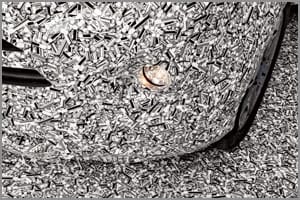Camouflage stickers protect prototype cars from industrial espionage
The great lengths car makers go to in order to protect new designs.
No matter what business you are in, you will always have a rival. Someone will do it better, faster, cheaper, or possibly all three. In 1997 a legal action between General Motors – makers of Chevrolet, Buick, Cadillac and GMC – and Volkswagen was settled with a pledge from Volkswagen to buy USD$1bn of GM parts over a seven-year period, and a once-off payment of USD$100m. The accusation – industrial espionage.
A bitter corporate battle had raged for years since the 1993 resignation of top executive Jose Ignacio Lopez from his role at GM and controversial move to Volkswagen. The Lopez Affair, as it became known, hinged on the transfer of strategy, business knowledge and processes developed by Lopez, who was infamous for lean purchasing and slashing suppliers’ prices.
Industrial espionage is alive and well, and in the ever more technologically advanced auto industry, corporations are going to great lengths to nip it in the bud. Every stage of the prototype development and manufacture process is ripe for the picking in the car industry.
In times past, professional photographers would lay in wait to see new car models being tested. Nowadays, anyone with a phone can take that crucial photo which blows the secret.
 HIDE AND SEEK
HIDE AND SEEK
In the development process, nothing can be left to chance, and new cars must undergo rigorous testing.
Industrial espionage is alive and well, and in the ever more technologically advanced auto industry, corporations are going to great lengths to nip it in the bud
To this end, many car manufacturers do take prototypes out on real roads, rather than merely sticking to their private test tracks.
Ford is one car company that has gone to great lengths to develop 3D patterned camouflage stickers to wrap their prototypes in, in order to deceive industry spies hoping to catch a glimpse of new cars being tested on public roads.
Ford spend about two months developing each new camouflage design; it is then printed up onto superfine vinyl wrap stickers and applied to the vehicle, while headlights and so on can be covered with mesh grilles.
“Almost everyone has a smartphone now and can share photos instantly – making it easy for anyone, including our rivals, to see vehicles in testing,” says Lars Muehlbauer, manager, Camouflage, Ford of Europe. “The designers create beautiful cars with cool design features. Our job is to keep those features hidden.”
The chaotic designs, inspired by 3D illusions, make it difficult to focus on the outlines and much harder for spies to discern new design features from cars spotted on the road or photos posted on fan sites. Ford’s latest design uses thousands of seemingly randomly placed black, grey and white cylinders in a chaotic criss-cross pattern.
This makes it especially difficult to discern new exterior features in sunlight, whether seen in person or on the millions of photographs and selfies that are posted to the internet.
CHAOTIC DESIGNS
“I tried to create a design which is chaotic and that confuses the eyes,” said Marco Porceddu, vehicle prototype engineer, Product Development, Ford of Europe, who developed the new camouflage. “I researched optical illusions on the internet and came up with a shape that could be copied and overlapped thousands of times. This creates both an optical illusion and a 3D effect.”
Anyone with a cameraphone can expose confidential design details
While the European versions come in black and white, designed to blend in with wintery European environments (and withstand extreme temperatures), sand colours are used in Australia and South America.
“This camouflage will stand out in almost any environment, but it’s designed to destroy the integrity of the vehicle’s shape, surfaces and colour, delaying your brain’s ability to recognise it, or its key features by sight,” said Martin Stevens, associate professor, University of Exeter; who has studied animal colouration and camouflage for almost 15 years.
“The optical illusion doesn’t prevent the car being seen, but plays with your ability to measure depth of field and shadows, making it difficult to see shapes and car features.”
Now that the taking of spy shots is no longer the preserve of professionals, anyone with a cameraphone can expose confidential design details; getting a new car to the launch date without any leaks is a coup.








